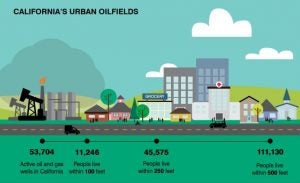 There are several reasons to be optimistic about environmental progress in Los Angeles. The city is making massive investments in electric vehicles, making clean energy more accessible to everyday people, and cutting pollution from the ports and freeways to name a few. But with over 60,000 Angelinos living less than 500 feet from an active oil well – LA could do more to protect our health and our environment.
There are several reasons to be optimistic about environmental progress in Los Angeles. The city is making massive investments in electric vehicles, making clean energy more accessible to everyday people, and cutting pollution from the ports and freeways to name a few. But with over 60,000 Angelinos living less than 500 feet from an active oil well – LA could do more to protect our health and our environment.
Oil and gas wells emit toxic chemicals that can increase our risk of developing asthma, cancer and other health problems. Recent studies by the California Air Resources Board and South Coast Air Quality Management District have uncovered elevated levels of benzene, a cancer causing agent, and other toxic compounds coming from oil and gas equipment in Huntington Beach and Signal Hill. In Santa Fe Springs a rupture at an oil site coated numerous homes with oil and generated noxious odors. Then there are the communities in Culver City, South LA, Compton and elsewhere living mere feet from drill sites who experience odors and health ailments on a regular basis. Most notoriously, the Porter Ranch community next to the Aliso Canyon gas field still reports respiratory problems and other symptoms stemming from a major gas leak in 2015.
In response to that disastrous gas leak, the Air Board required continuous pollution monitoring at the 12 natural gas storage sites in the state. The City followed up and imposed continuous monitoring requirements for two oil wells with a bad history of causing odors and community impacts. Last month, South Coast Air Quality Management required the five Southern California oil refineries to deploy real-time air quality monitors at their fencelines by 2020.
Unfortunately, aside from this small set of examples, few standards require continuous pollution monitoring at, or near, the other 54,000 active oil and gas sites across the state. As a result, communities and the government lack consistent, consolidated data on oil and gas emissions, leaving affected neighbors in the dark about their air quality.
In the past, price, availability and capability were barriers to the widespread deployment of continuous air quality monitoring systems. That is increasingly no longer the case. Dozens of companies now provide low- and mid-cost monitoring devices for commercial use.
With continuous pollution monitoring, oil and gas operators can pinpoint the location and the start-time of leaks in their system, minimize product loss, and reduce the risk of jeopardizing public health. Government agencies can regulate the industry more effectively, and communities can use monitoring data to hold neighboring companies accountable for their emissions.
If made public, the data yielded by a comprehensive network of pollution monitors at oil and gas sites could provide Californians with transparent and accurate pollution assessments — as opposed to the current system where facility-level emissions data are often kept confidential. The data can also enable government agencies to make better linkages between emissions and health effects, in order to take responsible actions to protect people.
It is time to take advantage of the technological advancements and make monitoring commonplace at all sites, especially those in closest proximity to communities. Everybody deserves to know what is in their air, Los Angeles has the power to make it happen.









